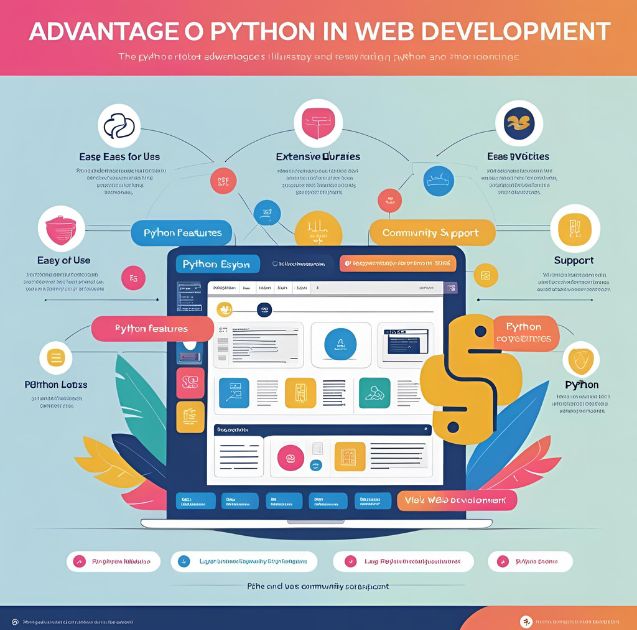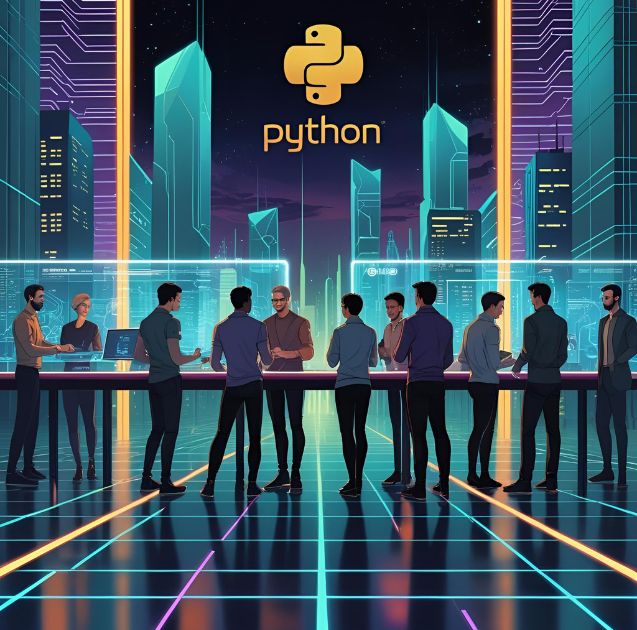Python is arguably one of the most popular programming languages for web development. Python was conceived in the late 1980s as a teaching language by programmer Guido van Rossum, who released the first version of the language in 1991. What began as a multi-use programming language is now the force behind how developers write websites and web applications.
After all, how is it that Python has become so popular in the field of web development? Then, how do you harness its features to create better web applications? In this post,t we will explain the place Python holds in the current world of web development, list the most important frameworks, and offer guidance for developers who want to leverage the power of Python.
The Python advantage in web development

Python’s rise in web development isn’t accidental. Several factors have contributed to its growing popularity among developers and organizations worldwide.
Clean, readable syntax
Python’s syntax closely resembles natural language, making it easier to write and maintain code. This readability advantage becomes crucial when working on large web development projects with multiple team members. Unlike languages that require extensive punctuation and complex syntax rules, Python allows developers to focus on solving problems rather than deciphering code structure.
Extensive library ecosystem
The Python Package Index (PyPI) contains over 400,000 packages, providing pre-built solutions for virtually every web development challenge. From database connectivity to image processing, and authentication systems to payment gateways, Python’s ecosystem offers mature, well-tested libraries that accelerate development cycles.
Rapid prototyping capabilities
Python’s concise syntax and powerful built-in functions enable developers to create functional prototypes quickly. This speed advantage is particularly valuable in web development, where rapid iteration and testing are essential for success. Teams can validate ideas and gather user feedback faster than with more verbose programming languages.
Strong community support
Python boasts one of the most active and supportive programming communities. This translates to abundant learning resources, quick problem-solving assistance, and continuous improvement of web development tools and frameworks. The community-driven approach ensures that Python remains current with web development trends and best practices.
Popular Python frameworks for web development
Python’s effectiveness in web development largely stems from its robust framework ecosystem. These frameworks provide structure, security features, and pre-built components that streamline the development process.
Django: The comprehensive solution
Django is the most complete web development framework for Python. It follows the “batteries included” philosophy and gives you everything you need to build a complex web application out of the box. Django comes with a bundled object-relational mapping (ORM) system, the admin interface, and its own contributed authentication and security.
Big-name sites that use Django for their web service infrastructure are Instagram, Pinterest, and The Washington Post. The focus of the framework is on reuse and comprehensibility as it caters largely to a large group of small and medium web developers.
Flask: Lightweight and flexible
Flask takes a minimalist approach to web development, providing core functionality while allowing developers to choose additional components as needed. This flexibility makes Flask particularly suitable for smaller web applications or projects with specific requirements that don’t fit Django’s opinionated structure.
Flask’s simplicity doesn’t mean it lacks power. Developers can extend Flask with numerous extensions for database integration, form handling, authentication, and more. This modular approach gives developers precise control over their web application’s architecture.
FastAPI: Modern and high-performance
FastAPI has emerged as a modern alternative for building APIs and web services. It combines Python’s ease of use with exceptional performance, often matching or exceeding the speed of Node.js and Go applications. FastAPI automatically generates API documentation and provides built-in data validation, making it increasingly popular for web development projects that require robust API functionality.
Pyramid: Scalable and adaptable
Pyramid offers a middle ground between Django’s comprehensive approach and Flask’s minimalism. It provides flexibility in choosing components while offering more built-in functionality than Flask. Pyramid’s configuration system allows developers to start small and add complexity as applications grow, making it suitable for both simple websites and complex web applications.
Python’s role in modern web development trends
Python has adapted well to contemporary web development practices and emerging technologies.
API-first development
Modern web development increasingly emphasizes API-first approaches, where applications expose their functionality through well-designed APIs. Python’s frameworks excel at creating RESTful APIs and GraphQL endpoints. FastAPI, in particular, has gained popularity for its automatic API documentation generation and high-performance capabilities.
Microservices architecture
Python’s modular nature and extensive library support make it well-suited for microservices architectures. Developers can create lightweight, focused services that communicate via APIs. Flask and FastAPI are particularly popular choices for microservices due to their minimal overhead and fast startup times.
Full-stack JavaScript alternatives
While JavaScript dominates client-side web development, Python offers compelling alternatives for full-stack development. Frameworks like Django can handle both backend logic and frontend templating, while tools like Brython and Pyodide enable Python execution in web browsers, challenging JavaScript’s client-side monopoly.
Machine learning integration
Python’s dominance in machine learning and data science creates unique opportunities for web development. Developers can seamlessly integrate AI capabilities into web applications using libraries like TensorFlow, PyTorch, and sci-kit-learn. This integration enables features like recommendation systems, image recognition, and predictive analytics within web applications.
Getting started with Python web development
Beginning your Python web development journey requires understanding both the language fundamentals and web-specific concepts.
Setting up your development environment
Start by installing Python from the official website or using a version manager like pyenv. Create virtual environments for each project to manage dependencies effectively. Use pip to install packages and consider using requirements.txt files to track project dependencies.
Choose a code editor or IDE that supports Python development. Popular options include Visual Studio Code, PyCharm, and Sublime Text. Configure your editor with Python-specific extensions for syntax highlighting, debugging, and code completion.
Learning the fundamentals
Before diving into web frameworks, ensure you understand Python’s core concepts: variables, data types, functions, classes, and modules. Practice with built-in data structures like lists, dictionaries, and sets. Understanding these fundamentals will make learning web development frameworks much easier.
Choosing your first framework
For beginners, Flask offers an excellent starting point due to its simplicity and clear documentation. Start with basic routes and templates, then gradually add features like database integration and form handling. Once comfortable with Flask’s concepts, you can explore Django for more complex projects or FastAPI for API development.
Building your first web application
Create a simple web application to practice your skills. Consider building a personal blog, to-do list, or portfolio website. Start with basic functionality and gradually add features like user authentication, database storage, and responsive design. This hands-on experience will solidify your understanding of Python web development concepts.
Best practices for Python web development
Successful Python web development requires following established best practices that ensure code quality, security, and maintainability.
Code organization and structure
Organize your code using clear directory structures and meaningful file names. Follow the principle of separation of concerns by keeping business logic separate from presentation logic. Use Python’s module system to create reusable components and avoid code duplication.
Security considerations
Web applications face numerous security threats, making security a critical consideration. Use framework-provided security features like CSRF protection, SQL injection prevention, and XSS filtering. Always validate user input and use parameterized queries for database operations. Keep your dependencies updated to patch security vulnerabilities.
Performance optimization
Monitor your application’s performance and optimize bottlenecks. Use caching mechanisms to reduce database queries and improve response times. Consider using content delivery networks (CDNs) for static assets. Profile your code to identify performance issues and optimize accordingly.
Testing and debugging
Implement comprehensive testing strategies using Python’s unit test framework or third-party alternatives like pytest. Write unit tests for individual functions and integration tests for complete workflows. Use debugging tools and logging to identify and fix issues quickly.
The future of Python in web development

Python’s role in web development continues to evolve with emerging technologies and changing industry needs.
WebAssembly integration
WebAssembly (WASM) opens new possibilities for running Python code in web browsers with near-native performance. Projects like Pyodide and Skulpt are making it possible to execute Python directly in browsers, potentially expanding Python’s reach in client-side web development.
Serverless computing
Python’s compatibility with serverless platforms like AWS Lambda, Google Cloud Functions, and Vercel makes it attractive for modern web development approaches. Serverless architectures can reduce costs and improve scalability for web applications with variable traffic patterns.
Progressive web applications
Python backends can power progressive web applications (PWAs) that provide native app-like experiences in web browsers. The combination of Python’s backend capabilities with modern frontend technologies creates opportunities for rich, interactive web applications.
Your next steps with Python web development
Python is an accessible language a logical stepping stone into the world of web and internet-based development. Whether you want to build simple web services or complex, large-scale web applications, the frameworks and ecosystem of Python are here to help.
Begin with the basics and practice Python before you delve into frameworks such as Flask or Django as the requirement for your project arises. Learn to build real apps, follow security best practices, and socialize with the Python community while learning.
Web development trends change over time, and Python as a language has a tendency to adapt to them. As you spend your time learning Python web development skills, you’re investing in a career in a field with no end in sight.







